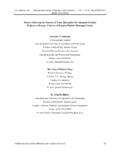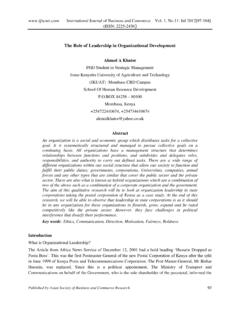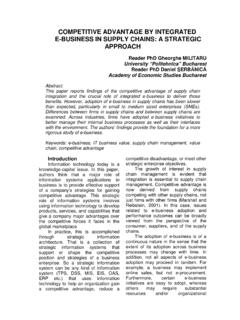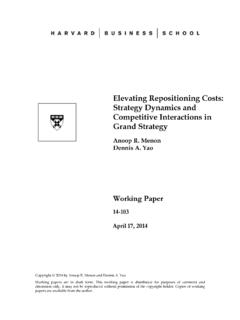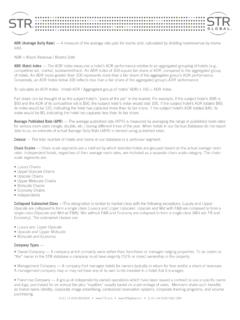Transcription of Competitive Advantage through Supply Chain …
1 International Journal of Business and Commerce Vol. 1, No. 7: Mar 2012[01-11] (ISSN: 2225-2436) Published by Asian Society of Business and Commerce Research 1 Competitive Advantage through Supply Chain Responsiveness and Supply Chain Integration Inda Sukati, Abu Bakar Abdul Hamid, Rohaizat Baharun, Mohd Norfian Alifiah, Melati Ahmad Anuar Faculty of Management and Human Resource Development Universiti Teknologi Malaysia Abstract In today s Competitive business, most of the firms increased focus on delivering value to the customer. The focus on attention of businesses is providing products and services that are more valuable compared to its competitors. This forces Supply Chain to be more responsive and create Competitive Advantage .
2 This research investigates the impact of Supply Chain integration on Competitive Advantage . The study also assesses the impact of Supply Chain responsiveness on firm Competitive Advantage . The data collection instrument used was a questionnaire which was administrated to a total sample of 400 managers in Malaysia manufacturing industry. The response rate was 62% while 50% was usable questionnaires. Sample selection was based on convenience sampling. The data were analyzed using mean, standard deviation and correlation between independent and dependent variables. The analyses involved statistical methods such as reliability and validity tests and multiple regressions. The research findings supported the hypotheses that Supply Chain integration positively impact Supply Chain responsiveness and Competitive Advantage . The finding also showed that Supply Chain responsiveness was positively associated with Competitive Advantage of a firm.
3 Introduction In Competitive business environment nowadays, the concept of Competitive Advantage has been discussed intensively in business strategy. Many scholars has defined the concept of Competitive Advantage , such as Li et at (2006) stated that Competitive Advantage is the capacity of an organization to create and maintenance defensible position over its competitors. Barney (2002) also suggested that Competitive Advantage obtained by the firm when its actions in an industry or market created economic value and few competing firms are engaging in similar actions. Furthermore, Tracey et al. (1999) argue that Competitive Advantage comprises of distinctive competencies that sets an organization apart from competitors, thus giving them an edge in the marketplace (Thatte, 2007). Traditionally, Competitive Advantage involved the particular choice regarding the market in which a firm would compete, depending on market share in clearly defined segment using price and product performance attribute (Day, 1994).
4 International Journal of Business and Commerce Vol. 1, No. 7: Mar 2012[01-11] (ISSN: 2225-2436) Published by Asian Society of Business and Commerce Research 2 Many previous studies have been focus on Supply Chain responsiveness. It is widely argued that the successful of business organization are largely depends on managing across all of Supply Chain parties (Christopher, 1992; Li et al., 2005; Vastag et al., 1994; Christopher and Peck, 2004; Academic Alliance Forum, 1999; Pelton et al., 1997). Lummus and Vokurka (1999). It is therefore need to dept investigate the responsiveness of a group of organization working together that called as Supply Chain . The field of study Supply Chain responsiveness is highly conceptual with little empirical research (Holweg, 2005; Storey et al.)
5 , 2005). Most of study emphasizes the importance of Supply Chain integration (Frohlich and Westbrook, 2001; Clinton and Closs, 1997). By addressing Supply Chain management practices that can lead responsiveness, will make better understanding the scope and activities related with Supply Chain management practices that create enhanced level of Supply Chain responsiveness in today s Competitive market place. Supply Chain integration is degree of all the activities within an organization, suppliers, and customers are integrated together (Stevens, 1990; Stock et al., 1998; Stock et al., 2000; Narasimhan and Jayaram, 1998). Supply Chain integration involves effective communication among all Supply Chain members (Turner, 1993). Integration is the term used to describe the various relationships that exist between departments within one company or the relationship between various companies.
6 For example, internally and externally, companies can integrate different activities within the operating company. This activity became apparent (such as product flow, finance, marketing, measurement, etc.) or intangible (such as relationships, information, etc.). Integration not only offers knowledge but also introduces many problems. Managers can design what kind of integration should be focused on, what action should be taken, when various types of overlapping of integration, and what procedures should be followed (Haozhe,2007). The level of Supply Chain integration will be able to generate Competitive Advantage of the firm. Mentzer et al (2001) The aim of this research is to find out the effect of Supply Chain responsiveness on Competitive Advantage . This study also assess the effect of Supply Chain integration in term of internal firm integration, integration with suppliers and integration with customer on firm Competitive Advantage .
7 The paper is organized as follows. Relevant literature is reviewed and synthesized first to develop a conceptual model, followed by research methodology. The results are then presented along with discussion. Literature Review and Hypotheses To gain Competitive Advantage , the firm need to better customer responds against competitors. Williamson, 1991; Martin and Grbac, 2003; Ellinger, 2000 stated that Competitive Advantage accrues to those company who are responsive to the customer needs and want. Lummus et al. (2003) argued that in the future, Supply Chain compete with other Supply Chain . In order to responds, business organization should understand that Supply Chain responsiveness towards customer needs. Creating responsiveness of Supply Chain has been become a source of Competitive Advantage of the firm (Lau and Hurley, 2001). Companies with more Supply Chain responsiveness will be more adaptive to demand fluctuation and can overcome the environment uncertainty at a lower cost due to the shorter lead time (Randall et al.)
8 , 2003). Yusuf et al. (1999) stated that lean manufacturing compromises responsiveness over cost efficiency. However, agile manufacturing place equal importance on both cost and responsiveness. Gunasekaran and Yusuf (2002) argued that the firm need to responsiveness and effectiveness. Responsiveness without cost effectiveness is not a real Competitive strategy. Thatte (2007) stated that Supply Chain responsiveness and International Journal of Business and Commerce Vol. 1, No. 7: Mar 2012[01-11] (ISSN: 2225-2436) Published by Asian Society of Business and Commerce Research 3 Competitive Advantage of the firm are positively related. Yusuf et al. (2003) found high correlation between the responsiveness and time to market, dependability, product innovation and quality.
9 Towill (2002) stated that the effective engineering of cycle time reduction will generate to significant improvements in manufacturing costs and productivity. Further he argued that reduction in lead times is the necessary condition for a responsive Supply Chain and which further reduces the time to market. Sharifi and Zhang (2001); Aitken et al. (2002), emphasize that responsiveness in the Supply Chain is a source of Competitive Advantage . (Allnoch, 1997) found that average companies required much more time to respond to changes in customer demand than did the leading manufacturers. In some cases, as much as eight times longer was required. Thatee, (2007) proposed that Supply Chain responsiveness shall reduce the costs, while leading to Competitive Advantage for firms on other dimensions as well. In operational level, responsiveness will enable organizations to compete based on cost, quality, time to market, and delivery dependability; responsiveness of a firm s logistics (transportation and distribution) process will enable organizations to introduce new products faster than major competitors and also lead to greater ability of a firm to provide on time the type and volu me of product required by customers ( increasing delivery dependability); responsiveness of a firm s supplier network will improve - the ability of the firm to rapidly introduce new products and features in the market place ( compete based on product innovation and time to market), as well as improve a firm s ability to provide on time delivery ( increase its delivery dependability) as these firms will be endowed with responsive suppliers.
10 Li, (2002) proposed that a Supply Chain characterized by quick responsiveness to customer will Competitive in term of time and quality. A Supply Chain consists of all stages involved, either directly or indirectly, in fulfilling a customer request. A Supply Chain includes manufacturer, supplier, transporters, warehouses, retailer, third-party logistic provider, and customer. The objective of Supply Chain management is to maximize the overall value generated rather than profit generated in a particular Supply Chain (Chopra, and P, Meindl, 2001). Robert Sturim (1999) stated that achieving Competitive Advantage through Supply Chain integration. Further more he argued that responsiveness to customer need requires high degree of Supply Chain integration and information sharing between partners in Supply Chain . Based on the above literature review, research framework can be drawn as follow: Figure 1: Proposed research framework International Journal of Business and Commerce Vol.

